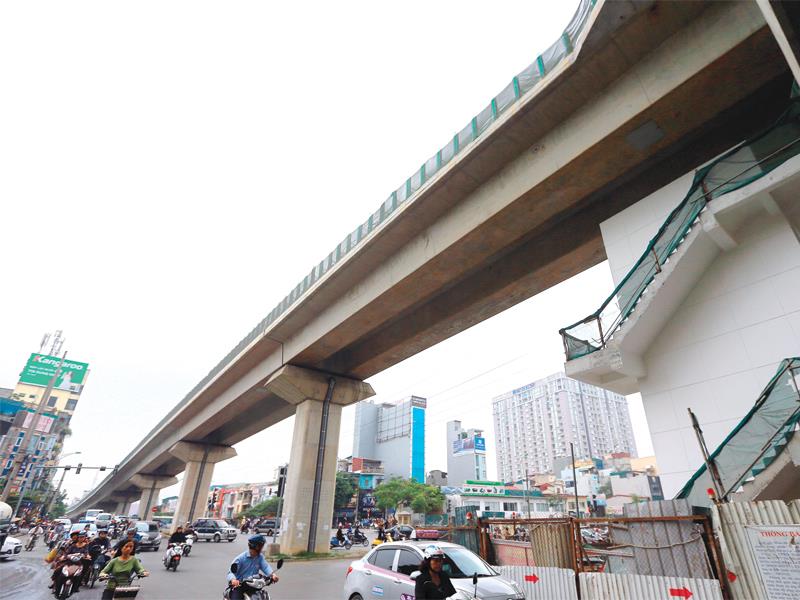Speeding up ODA and public investments crucial to avoid economic backlash
| Slow disbursement hinders ODA transport projects | |
| PM issues ultimatum to speed up ODA projects | |
| PM urges faster capital disbursement |
 |
| The Cat Linh-Hadong urban railway project uses ODA funds from China |
Behind slow disbursement
In the online talk show “ODA Fund and Public Investment Disbursement: Transparency and Efficiency” on August 8, 2017, the reasons behind the slow disbursement were enumerated and discussed at great length.
In particular, Tran Quoc Phuong, head of the Department for National Economic Issues (under the Ministry of Planning and Investment–MPI), said the first reason lies in the habits of Vietnamese people. Fund disbursement at the beginning of the year is quite slow and picks up pace by the end of the year.
Another reason is that site clearance is complicated, especially for huge projects stretching across enormous land areas. Implementing the necessary procedures as well as cooperation among contractors and related agencies is slow—and one slow step after another adds up to hefty delays.
“Fund disbursement has to rely on state regulations and requires the fulfillment of many administrative procedures, such as the submission of various documents and dossiers to receive project approval, and so on. Completing all procedures may take a very long time with numerous steps of hiring consultants, conducting a pre-feasibility study, a feasibility study, and implementing other procedures for appraisal. These processes slow down fund disbursement,” Phuong said.
Luu Quang Khanh, head of MPI’s Foreign Economic Relations Department, agreed with Phuong, and added that regarding ODA funds, problems also originate from the different procedures in Vietnam and Japan, the shortage of reciprocal capital, and the lack of an appropriate regulation to keep the disbursement on schedule.
Speeding up and promoting efficiency
According to the statistics of the Ministry of Finance, as of the end of July 2017, more than VND41.7 trillion ($1.8 billion) of ODA funds have been disbursed, completing 42 per cent of the 2017 plan. However, this amount equalled 95 per cent of the disbursed amount in the corresponding period last year.
Meanwhile, the disbursement of public investment in the first seven months of 2017 was nearly VND119.4 trillion ($5.3 billion), an equivalent of 38.6 per cent of the amount assigned by the government.
Phuong said that fund disbursement was enhanced, but still fails to meet expectations. Thus, a wide range of solutions were drawn up, including reducing administrative procedures, transferring funds from delayed projects to those on schedule and so on.
Speeding up ODA fund and public investment disbursement would not only spur the economy but also ensure the efficient usage of funds.
According to recent statistics of MPI, the incremental capital output ratio (ICOR), the metric that reflects the efficient usage of investment to spur the economy, has decreased.
In the first half of 2017, ICOR was 5.72, a reduction of 24 basis points compared to the same period last year. This decline implies improvements in the usage of funds.
According to the Asian Development Bank (ADP)’s 2013 report, expenses for project implementation may increase by 17.6 per cent for each year of delay. This contains 6.5 per cent due to inflation and 11.1 per cent from the loss of project benefits. If the projects are behind schedule for 2-3 years, the expenses may rise by 50 per cent on average.
This is a considerable concern, especially as the World Bank cut down on preferential loans for Vietnam since July 2017 and ADB also plans to stop from January 2019. Similarly, other Japanese and South Korean donors also plan to replace their current preferential loans with other vehicles at higher interest rates and shorter terms.
What the stars mean:
★ Poor ★ ★ Promising ★★★ Good ★★★★ Very good ★★★★★ Exceptional
Latest News
More News
- Global partnerships key to Vietnam’s IFC development (December 26, 2025 | 16:18)
- Vingroup pulls out of bid to invest in North-South high-speed railway (December 26, 2025 | 11:42)
- Strengthening supply chains through trade promotions and customs reform (December 24, 2025 | 14:00)
- PM orders investment model for North–South high-speed rail (December 22, 2025 | 17:43)
- LS Eco Energy to invest in Vietnam rare earth sector (December 22, 2025 | 17:31)
- Government moves to establish International Financial Centre (December 21, 2025 | 21:00)
- Vietnam's IFC to target global investment flows (December 21, 2025 | 18:00)
- Two national hospitals expand capacity with new facilities (December 20, 2025 | 09:00)
- Ha Tinh breaks ground on major Vingroup industrial and energy projects (December 19, 2025 | 18:24)
- EVN launches major power infrastructure projects nationwide (December 19, 2025 | 18:17)

















 Mobile Version
Mobile Version